| In Meiji period (1868-1912), many
tea productions and business book published and production technic was greatly
advanced. Although steaming is done by hand not by machine, however advanced production
method brings to serve almost present day's tea. Japanese green tea, as completion
of production method, massively exported to overseas. At that time, silk material
and Japanese green tea was Japanese leading export products. In this section,
through tea books published in Meiji period (1868-1912) we look advance of production
method and export. |
 |
| "Kaitoryu-Sencha-seizouho"(Kaitouryu
tea production method) ,Kanju atsusita, (Ogasa cho Ogasa gun Sizuoka prefecture,
1890, National Library) Kanju Matsusita served rubbing teacher Tamasaburo Akahori
and after Akahori's death, Matsusita inherited tea production method and improved
it, then created Kaitoryu.
How to make fire, how to steam tea leaves, how to rub, first rubbing second
rubbing, final rubbing are described in this book.This method is middle quality
tea production method. Therefore, it is written that except tea appearance, this
method produces true tea and core of this method production (Kaitoryu) is cooling
down by rubbing on hearth. "Kairyo-Sencha-ho"(Improved tea production
method) Icizo Saito (Abe gun, Sizuoka prefecture, 1907, National library)
It is written that tea is not Japanese oriented but India, China oriented and
in order to compete these area's teas, Japanese produce superior Japanese green
tea. Saito written tea production method comes from his many experiences and described
tea garden improvement, how to handle tea leaves, how to construct tea hearth,
drying, improved tea production, how to handle manure. |
|
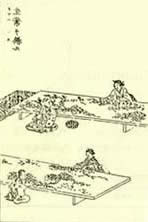
|
 |
| "Tea plantation" Sin Sugita It is
written that this book is tea production for export. Also tea business management
is written. In production section, Sugita described management of 100ha tea garden
and reproduction of export tea as well as tea production. |
|
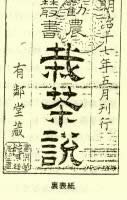 |
 |
| "Seicha-tebiki"(Tea production guidebook)
Juken Nagatani (Grand son of Sencha founder Souen Nagatani) Nagatani described
tea garden cultivation, menure, tea production. |
|
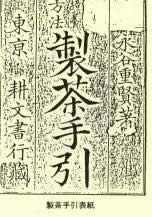 |
 |
| "Cha seike-hikkei" ( Tea business man
hand book) Seizaemon Tanaka (Airaku gun Kyoto-fu ,1886, National library)
It is written in preface that Japanese most important export product, Japanese
green tea price was better than before because of quality improvement and we had
to improve Japanese green tea further and spreaded Japanese beauty to overseas.
Tanaka described how to pluck tea, how to steam, how to dry, how to preserve,
how to adjust overseas needs,reproduction, comparison of original production tea,
break even calculation of old leaves and new leaves.
This book shows how tea man in Meiji period(1868-1912) was enthusiastic to
produce tea. "Ryokucha-seizouhou"(Green tea production method) Tyosaku
Ezawa (Simada-si Sizuoka prefecture, 1891, National library)
It is written that haw to rub Tenkaichi tea, etc, how to rub Gykuro tea, tea
production, preservation, reproduction, how to make box for export.
"Seicha Zukai"( Tea production illustration) Hikone-han (Hikone state,1872)
Before the abolition of clans and establishment of prefectures, Hikone-han
wrote tea production with illustration for normal farmers in order to develop
tea agriculture. |
|
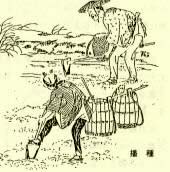
|
 |
| "Seicha-sinsetu" (Tea production new
theory) Juseki Matsuda "Seicha-sinsetsu" published two years after
Hikone-han had published "Seicha-zukai".
Like "Seicha-zukai", it is written in illustration in order to understand
easily.
It is described tea crops, how to sow tea crops, how to recognize sex of tea
tree, how to cultivate tea tree, how to pluck tea leaves, manure, tea production
method, covered tea production, prevention for insects. |
|
 |
 |
| In this way, Many tea books were published and
almost present Sencha tea was completed.
In the mean time, teas were exported massively to overseas (mainly US).
In 1878, almost teas on Japanese distribution channel were exported and the
quantity of tea export was twice that of tea export from China.
In 1884, Kenzo Takahashi invented steaming machine and heating machine as well
as friction machine.
15 years later he invented rubbing machine and brought quasi machine production
to Japanese green tea industry.
1890, Japanese green tea industry opened tea shop in Paris global exhibition. |
|
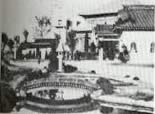 |
 |
 |
 |
|

